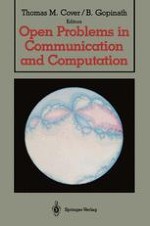1987 | OriginalPaper | Buchkapitel
Essential Average Mutual Information
verfasst von : Yaser S. Abu-Mostafa
Erschienen in: Open Problems in Communication and Computation
Verlag: Springer New York
Enthalten in: Professional Book Archive
Aktivieren Sie unsere intelligente Suche, um passende Fachinhalte oder Patente zu finden.
Wählen Sie Textabschnitte aus um mit Künstlicher Intelligenz passenden Patente zu finden. powered by
Markieren Sie Textabschnitte, um KI-gestützt weitere passende Inhalte zu finden. powered by
Consider two dependent random variables (S, C) and suppose that $$\hat{\chi }$$ is the optimal estimate of C when only S is known. I(S; C) is a measure of how much S tells us about C, and $$I(\hat{\chi } ; C)$$ is a measure of how much our optimal estimate $$\hat{\chi }$$ tells us about C. What can we say about $$I(\hat{\chi } ; C)$$ if we know that I(S; C) = 3 bits, for example? The optimality of $$\hat{\chi }$$ suggests that $$I(\hat{\chi } ; C)$$ should also be close to 3 bits. This is what we address in this problem. Let (S, C) be jointly distributed ~p(s,c), where S = {0,..., N−1}, and C = {0,..., M−1}. Let $$\hat{\chi }:\{ 0, \ldots ,N - 1\} \to \{ 0, \ldots ,M - 1\}$$ denote an arbitrary function of the outcomes of S. The problem is to estimate the numbers α(N, M) defined by $$\alpha (N,M) = \mathop{{\inf }}\limits_{{p:I(S;C) > 0}} \mathop{{\max }}\limits_{{\hat{\chi } = \hat{C}(S)}} \left( {\frac{{I(\hat{\chi };C)}}{{I(S;C)}}} \right)$$ Since $$I(\hat{\chi };C) \leqslant I(S;C)$$ (data processing inequality), α(N, M) ≤ 1 . In fact, α(N, M) < 1 for N, M as shown in the following example for α(3, 2).
